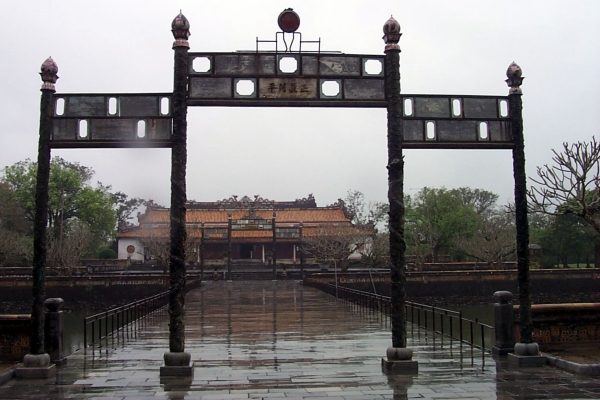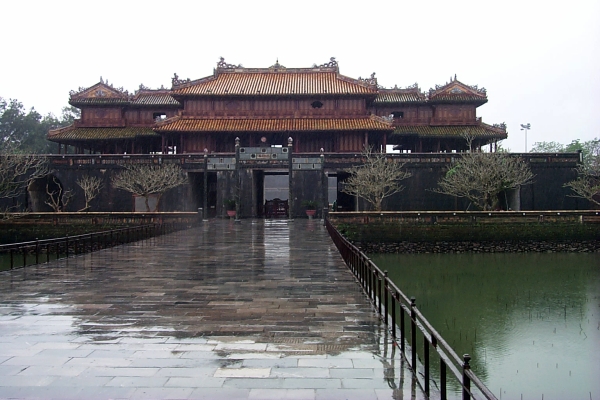The main reason to visit Hue is the citadel of the old capitol, along with the royal tombs scattered around the countryside. The citadel was begun in 1804 and served as Vietnam's capital until around 1945. The first thing you'll see on approaching it is the big flag tower (Cot Co). The photo above was taken from the Ngo Mon Gate, the main entrance to the citadel. All visitors must enter by this gate, and pay the 55,000 Dong (-55,000.00 USD) entrance fee.
 The bridge across a moat to the Thai Hoa Palace
The bridge across a moat to the Thai Hoa Palace
The lower part of the gate is stone, while on top is the "Belvedere of the Five Phoenixes" where the emperor appeared on important occasions, and where the last emperor abdicated to Ho Chi Minh's Revolutionary Government in 1945.
 The Phoenix Gate to the citadel, from the inside.
The Phoenix Gate to the citadel, from the inside.
Just inside the gate is a lotus pond with a bridge once reserved for the emperor's private use. Across the bridge is the Thai Hoa Palace used for official receptions and other important court ceremonies. The columns supporting the roof are lacquered and inlaid with gold.
Behind the Thai Hoa Palace are a pair of smaller halls used by mandarins to prepare for court ceremonies. The halls form a courtyard, the fourth side of which was once a wall dividing the more public area of the citadel from the emperor's private residence, the "Forbidden Purple City." The name conjures up images of grand palaces like Beijing. Unfortunately, it takes quite a bit of imagination to picture the buildings that once occupied what is now a grassy expanse. What wasn't destroyed by a fire in 1947 was bombed in the 1968 Tet Offensive. The picture at above left was taken from the upper-most level looking back at the Thai Hoa palace and the Flag tower.
 You have to use your imagination to see the Forbidden Purple City, as most of it was destroyed in the wars
You have to use your imagination to see the Forbidden Purple City, as most of it was destroyed in the wars
Off to one side of the central axis of the forbidden city, about midway, is the Thai Binh Lau or Royal Library. This small building stands in a garden and is fronted by small pond mostly taken up by a mountain-island well-grown with moss and bonsai. You will find similar ponds, fountains or even large bowls of water in many structures all over Vietnam.
Although you must enter the citadel through the main gate, you can exit it at several other points. Between the Thai Hoa palace and the halls of the mandarins, a path leads to the Hien Nhon gate. Leaving by this gate is the shortest route to get from the forbidden city to the museum at Long An palace. Along the path are a couple of buildings worth a look.